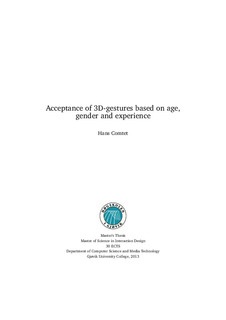Acceptance of 3D-gestures based on age, gender and experience
Master thesis
Permanent lenke
http://hdl.handle.net/11250/144043Utgivelsesdato
2013Metadata
Vis full innførselSamlinger
- Institutt for design [1151]
Sammendrag
Older people are increasingly using technology in their daily lives, but at the same time, they often experience problems when interacting with new technology. Younger adults have more experience in using new technology, but are being challenged by the development towards mobile computing with new interaction options like 3D-gestures. In gaming, 3D-gestures are perceived as natural and enjoyable, thereby promising to be a matching interaction technique for future interaction scenarios. Nevertheless, relevant research areas agree on the challenge whether or not 3D-gestures are better than existing techniques in a human computer interaction context. Less experience means fewer expectations and assumptions about how novel interaction techniques work and how they should be approached. Differences in experience are also an interesting domain when looking into the intuitiveness of technology, meaning the extent to which the specific technology can be used without earlier experience or training. Rather than age or gender, experience could therefore be an important factor for the acceptance of 3D-gestures, which is what this project aims to investigate further in carrying out a between-subject study. An experimental laboratory set-up was used to simulate a TV interaction and game task to evoke natural gestures. The performed gestures were recorded on video by using a kinect for XBox and Windows. Gestures were also recorded with an accelerometer device around participants wrists. The acceptance of the 3D-gesture interaction was analyzed by a triangulation of open questions, observations and the UTAUT2 research model [1]. The findings indicate that both age groups enjoyed performing 3D-gestures. Previous experience with certain devices has an influence on the acceptance, however gender was not found to have any influence. Likewise, age has no influence on the acceptance, although the fun factor seems to be less important with increasing age. Both age groups want a 3D-gesture-based system to be helpful, easy and supporting. The findings also indicate that participants had slightly varying opinions on whether 3D-gestures are helpful or unnecessary. Together with the results from the gesture recognition, this thesis contributes with successfactors and characteristics of the research group. The discovered differences and similarities can be used for future developments and designs, as well as improve the acceptance of 3D-gesture interaction.
